An Experimental Study of a Thermally Activated Ceiling Containing Phase Change Material for Different Cooling Load Profiles
Abstract
:1. Introduction
2. Materials and Methods
- C0—Stefan–Boltzmann constant, C0 = 5.67∙ 10−8 W/(m2 ∙ K4);
- TP—temperature of the non-activated surfaces, [K];
- TS—surface temperature of activated panels, [K]; and
- ε1, ε2—emissivity of the emitting surface and emissivity of the heat absorbing surface (for building materials: ε1, ε2 = 0.9–0.95), [-];
- —field of the emitting surface and the heat absorbing surface, [m2]; and
- —view factor [-].
- αc—convective heat transfer coefficient, [W/m2 K];
- ti—air temperature in room, [°C]; and
- ts—surface temperature of thermally activated panels, [°C].
- in a heating mode ():
- in a cooling mode ():
- —characteristic dimension of radiant ceiling panel, [m];
- —thermal conductivity of air, [W/(m·K)];
- Nu—Nusselt number, [-];
- —Rayleigh number, [-];
- Pr—Prandtl number, [-];
- Gr—Grashof number, [-];
- —thermal expansion coefficient, [m/s2];
- g—gravitational acceleration, [m/s2];
- —density of air, [kg/m3];
- ts − ti—temperature difference between thermally activated surface and air, [K]; and
- —dynamic viscosity of air, [kg/(ms)].
- —water mass flow rate, [kg/s];
- —difference between supply and return water temperature, [K];
- —specific heat capacity, [J/(kg∙K)]; and
- —area of thermally activated surface, [m].
- —constant of the characteristic equation, [-];
- —temperature difference of the active surface, [K]; and
- —exponent of the characteristic equation of the active surface, [-].
2.1. Experimental Chamber
2.2. Apparatus and Accuracy
2.3. PCM in Thermally Activated Modules
2.4. Cooling Ceiling Modules—Steady State
3. Results and Discussion
4. Conclusions
- —heat gains, [W];
- —time step (period of occurrence of cooling load), [s];
- —total heat flux density (period of occurrence of cooling load), [W/m2];
- —area of thermally activated ceiling, [m2];
- PCM enthalpy difference for system operation range, [J/kg];
- —PCM mass, [kg]; and
- —period of occurrence of cooling load.
Author Contributions
Funding
Institutional Review Board Statement
Informed Consent Statement
Data Availability Statement
Conflicts of Interest
References
- Ratajczak, K.; Szczechowiak, E. The Use of a Heat Pump in a Ventilation Unit as an Economical and Ecological Source of Heat for the Ventilation System of an Indoor Swimming Pool Facility. Energies 2020, 13, 6695. [Google Scholar] [CrossRef]
- Sinacka, J.; Ratajczak, K. Analysis of selected input data impact on energy demand in office building—Case study. MATEC Web Conf. 2018, 222, 01015. [Google Scholar] [CrossRef]
- Sinacka, J.; Szczechowiak, E. Operational Analysis for Passive House in Aspect of Climate Comfort and Energy Demand. Dist. Heat. Heat. Vent. 2017, 48, 497–504. (In Polish) [Google Scholar]
- Amanowicz, Ł.; Wojtkowiak, J. Experimental investigations of thermal performance improvement of aluminum ceiling panel for heating and cooling by covering its surface with paint. In Proceedings of the 10th Conference on Interdisciplinary Problems in Environmental Protection and Engineering EKO-DOK, Zdrój, Poland, 14–16 April 2018; Volume 44. [Google Scholar] [CrossRef]
- Wojtkowiak, J.; Amanowicz, T.; Mróz, T. A new type of cooling ceiling panel with corrugated surface—Experimental investigation. Int. J. Energy Res. 2019, 43, 7275–7286. [Google Scholar] [CrossRef]
- Wojtkowiak, J.; Amanowicz, T. Effect of surface corrugation on cooling capacity of ceiling panel. Therm. Sci. Eng. Prog. 2020, 19, 100572. [Google Scholar] [CrossRef]
- Romaní, J.; de Gracia, A.; Cabeza, L.F. Simulation and control of thermally activated building systems (TABS). Energy Build. 2016, 127, 22–42. [Google Scholar] [CrossRef] [Green Version]
- Romaní, J.; Cabeza, L.F.; Pérez, G.; Pisello, A.L.; de Gracia, A. Experimental testing of cooling internal loads with a radiant wall. Renew. Energy 2018, 116, 1–8. [Google Scholar] [CrossRef] [Green Version]
- Glück, B. Thermische Bauteilaktivierung—Nutzen von Umweltenergie und Kapillarrohren; C. F. Müller: Heidelberg, Germany, 1999. [Google Scholar]
- Sahan, N.; Paksoy, H. Determining influences of SiO2 encapsulation on thermal energy storage properties of different phase change materials. Sol. Energy Mater. Sol. Cells 2017, 159, 1–7. [Google Scholar] [CrossRef]
- Sharma, A.; Tyagi, V.V.; Chen, C.R.; Buddhi, D. Review on thermal energy storage with phase change materials and applications. Renew. Sustain. Energy Rev. 2009, 13, 318–345. [Google Scholar] [CrossRef]
- Soares, N.; Costa, J.J.; Gaspar, A.R.; Santos, P. Review of passive PCM latent heat thermal energy storage systems towards buildings’ energy efficiency. Energy Build. 2013, 59, 82–103. [Google Scholar] [CrossRef]
- Gwerder, M.; Tödtli, J.; Lehmann, B.; Renggli, F.; Dorer, V. Control of Thermally Activated Building Systems. In Proceedings of the 9th REHVA World Congress Clima, WellBeing Indoors, Helsinki, Finland, 10–14 June 2007. [Google Scholar]
- Renggli, F.; Gwerder, M.; Tödtli, J.; Lehmann, B.; Dorer, V. Effect of The Hydraulic Piping Topology on Energy Demand and Comfort in Buildings with Tabs. In Proceedings of the 9th REHVA World Congress Clima, WellBeing Indoors, Helsinki, Finlandy, 10–14 June 2007. [Google Scholar]
- Gwerder, M.; Lehmann, B.; Tödtli, J.; Dorer, V.; Renggli, F. Control of thermally-activated building systems (TABS). Appl. Energy 2008, 85, 565–581. [Google Scholar] [CrossRef]
- Gwerder, M.; Tödtli, J.; Lehmann, B.; Dorer, V.; Güntensperger, W.; Renggli, F. Control of thermally activated building systems (TABS) in intermittent operation with pulse width modulation. Appl. Energy 2009, 86, 1606–1616. [Google Scholar] [CrossRef]
- Tödtli, J.; Gwerder, M.; Lehmann, B.; Renggli, F.; Dorer, V. TABS Control: Steuerung und Regelung von Thermoaktiven Bauteilsystemen; FAKTOR Verlag AG: Zürich, Switzerland, 2009. [Google Scholar]
- Tödtli, J.; Gwerder, M.; Renggli, F.; Güntensperger, W.; Lehmann, B.; Dorer, V.; Hildebrand, K. Regelung und Steuerung von thermoaktiven Bauteilsystemen (TABS). Bauphysik 2009, 31, 319–325. [Google Scholar] [CrossRef]
- Pałaszyńska, K.; Bandurski, K.; Porowski, M. Energy demand and thermal comfort of HVAC systems with thermally activated building systems as a function of user profile. E3S Web Conf. 2017, 22, 00130. [Google Scholar] [CrossRef] [Green Version]
- Lacarte, L.M.D.; Fan, J. Modelling of a thermally activated building system (TABS) combined with free-hanging acoustic ceiling units using computational fluid dynamics (CFD). Build. Simul. 2018, 11, 315–324. [Google Scholar] [CrossRef] [Green Version]
- Michalak, P. Selected Aspects of Indoor Climate in a Passive Office Building with a Thermally Activated Building System: A Case Study from Poland. Energies 2021, 14, 860. [Google Scholar] [CrossRef]
- Sinacka, J.; Szczechowiak, E. Heat Flow Modelling in a Building with Thermally Activated Building Systems. Dist. Heat. Heat. Vent. 2018, 49, 271–278. (In Polish) [Google Scholar]
- Pomianowski, M.; Khalegi, F.; Domarkas, G.; Taminskas, J.; Bandurski, K.; Madsen, K.; Gedsø, S.; Lund, R. Experimental investigation of the influence of obstacle in the room on passive night-time cooling using displacement ventilation. In Proceedings of the 9th Nordic Symposium on Building Physics—NSB, Tampere, Finland, 29 May–2 June 2011. [Google Scholar]
- Koschenz, M.; Lehmann, B. Development of a thermally activated ceiling panel with PCM for application in lightweight and retrofitted buildings. Energy Build. 2004, 36, 567–578. [Google Scholar] [CrossRef]
- Boiting, B.; Hollenbeck, P. PCM-Kühldecken. Teil 1: Grundlagen. HLH Klimatech. 2013, 64, 108–111. [Google Scholar]
- Boiting, B.; Hollenbeck, P. PCM-Kühldecken. Teil 2—Berechnungs- und Auslegungsverfahren. HLH Klimatech. 2013, 64, 88–91. [Google Scholar]
- Boiting, B.; Hollenbeck, P. PCM-Kühldecken. Teil 3—Neue Ansätze. HLH Klimatech. 2013, 64, 74–76. [Google Scholar]
- Anonymous. Ventilation for Buildings—Chilled Ceilings—Testing and Rating; EN 14240; CEN: Brussels, Belgium, 2004. [Google Scholar]
- Klinker, F.; Weinläder, H.; Konstantinidou, A.C. Dynamic Thermal Behaviour of Two Newly Developed PCM Cooling Ceiling Prototypes. In Proceedings of the EuroSun 2014, Aix-Les-Bains, France, 16–19 September 2014. [Google Scholar]
- Weinläder, H.; Klinker, F.; Yasin, M. PCM cooling ceilings in the Energy Efficiency Center—Regeneration behaviour of two different system designs. Energy Build. 2017, 156, 70–77. [Google Scholar] [CrossRef]
- Weinläder, H.; Klinker, F.; Yasin, M. PCM cooling ceilings in the Energy Efficiency Center—Passive cooling potential of two different system designs. Energy Build. 2016, 119, 93–100. [Google Scholar] [CrossRef]
- Yasin, M.; Scheidemantel, E.; Klinker, F.; Weinläder, H.; Weismann, S. Generation of a simulation model for chilled PCM ceilings in TRNSYS and validation with real scale building data. J. Build. Eng. 2019, 22, 372–382. [Google Scholar] [CrossRef]
- Allerhand, J.Q.; Kazanci, O.B.; Olesen, B.W. Energy and thermal comfort performance evaluation of PCM ceiling panels for cooling a renovated office room. CLIMA 2019, 111, 03020. Available online: https://www.e3s-conferences.org/articles/e3sconf/abs/2019/37/e3sconf_clima2019_03020/e3sconf_clima2019_03020.html (accessed on 1 October 2021).
- Bourdakis, E.; Pean, T.Q.; Gennari, L.; Olesen, B.W. Daytime space cooling with phase change material ceiling panels discharged using rooftop photovoltaic/thermal panels and night-time ventilation. Sci. Technol. Built Environ. 2016, 22, 902–910. [Google Scholar] [CrossRef] [Green Version]
- Bourdakis, E.; Olesen, B.W.; Grossule, F. Night time cooling by ventilation or night sky radiation combined with in-room radiant cooling panels including phase change materials. In Proceedings of the 36th AIVC Conference, Madrid, Spain, 23–24 September 2015. [Google Scholar]
- Bogatu, D.-I.; Kazanci, O.B.; Olesen, B.W. An experimental study of the active cooling performance of a novel radiant ceiling panel containing phase change material (PCM). Energy Build. 2021, 243, 110981. [Google Scholar] [CrossRef]
- Cholewa, T.; Anasiewicz, R.; Siuta-Olcha, A.; Skwarczynski, M.A. On the heat transfer coefficients between heated/cooled radiant ceiling and room. Appl. Therm. Eng. 2017, 117, 76–84. [Google Scholar] [CrossRef]
- Cholewa, T.; Rosiński, M.; Spik, Z.; Dudzińska, M.R.; Siuta-Olchaa, A. On the heat transfer coefficients between heated/cooled radiant floor and room. Energy Build. 2013, 66, 599–606. [Google Scholar] [CrossRef]
- Wojtkowiak, J.; Amanowicz, Ł. Investigation of heating and cooling power of ceiling panel. Dist. Heat. Heat. Vent. 2016, 47, 413–417. (In Polish) [Google Scholar]
- Sinacka, J.; Szczechowiak, E.; Żabicka, P. Influence of usage profile on energy needs for heating and cooling in a building with thermally activated building systems. Instal 2019, 10, 34–37. (In Polish) [Google Scholar]
- Sinacka, J. Thermal Properties of Heating and Cooling Ceilings Filled with Phase Change Material. Ph.D. Thesis, Poznan University of Technology, Poznan, Poland, 2021. (In Polish). [Google Scholar]
- Amanowicz, L. Controlling the Thermal Power of a Wall Heating Panel with Heat Pipes by Changing the Mass Flowrate and Temperature of Supplying Water—Experimental Investigations. Energies 2020, 13, 6547. [Google Scholar] [CrossRef]
- Zhou, X.; Lochhead, S.J.; Zhong, Z.; Van Huynh, C. Low Energy LED Lighting Heat Distribution in Buildings; ASHRAE Research Project RP-1681, Final Raport; ASHRAE: Atlanta, GA, USA, 2016; 176p. [Google Scholar]
- Liu, R.; Zhou, X.; Lochhead, S.J.; Zhong, Z.; Van Huynh, C.; Maxwell, G.M. Low-energy LED lighting heat gain distribution in buildings, part II: LED luminaire selection and test results. Sci. Technol. Built Environ. 2017, 23, 688–708. [Google Scholar] [CrossRef]
- Koca, A.; Gürsel, C. Experimental investigation on the heat transfer coefficients of radiant heating systems: Wall, ceiling and wall-ceiling integration. Energy Build. 2017, 148, 311–326. [Google Scholar] [CrossRef]
- Koca, A.; Acikgoz, O.; Cebi, A.; Cetin, G.; Dalkilic, A.S.; Wongwises, S. An experimental investigation devoted to determine heat transfer characteristics in a radiant ceiling heating system. In Heat Mass Transfer; Springer: New York, NY, USA, 2017; pp. 1–13. [Google Scholar]
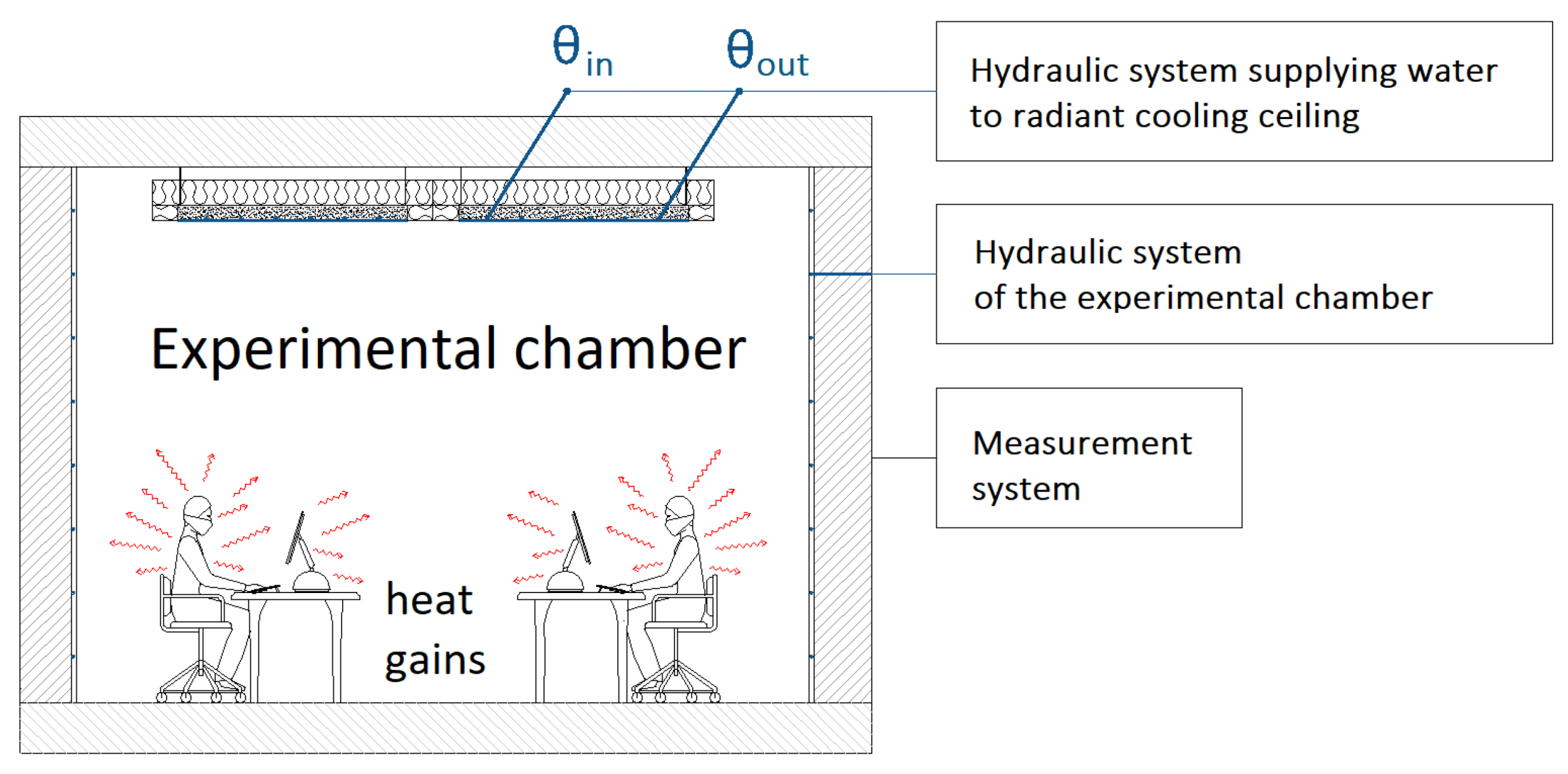

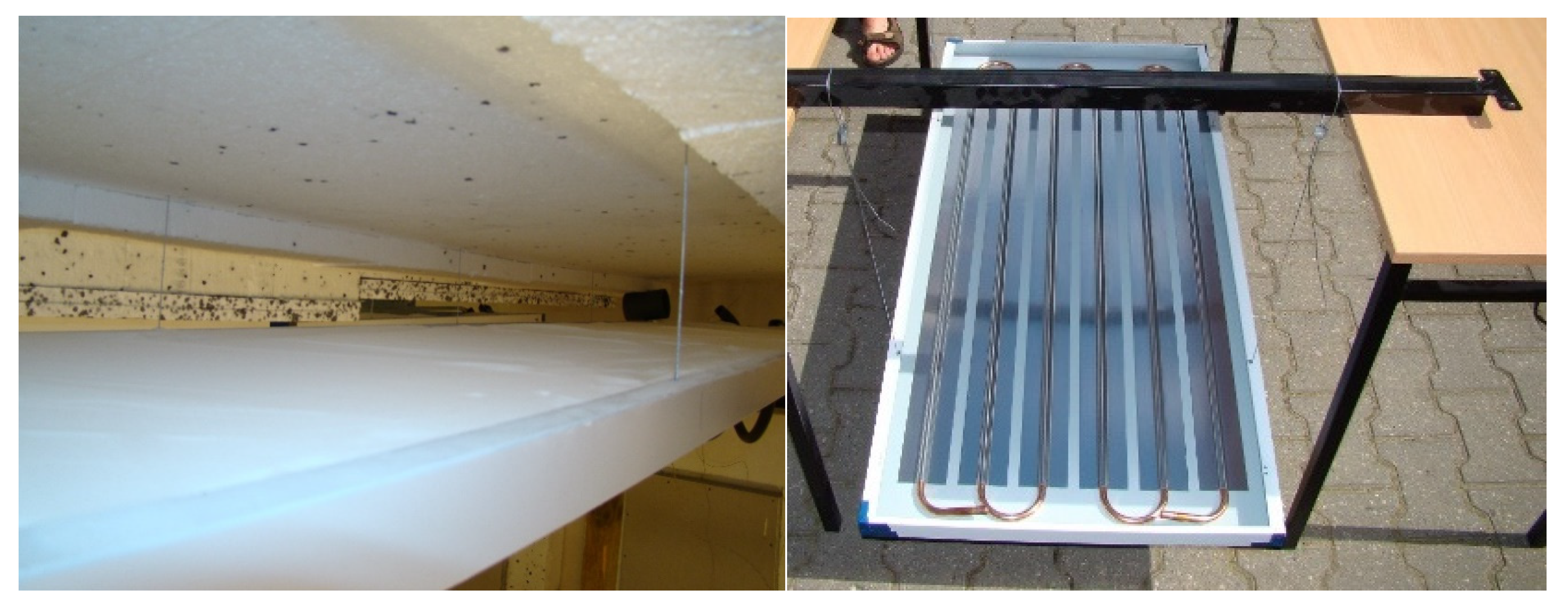
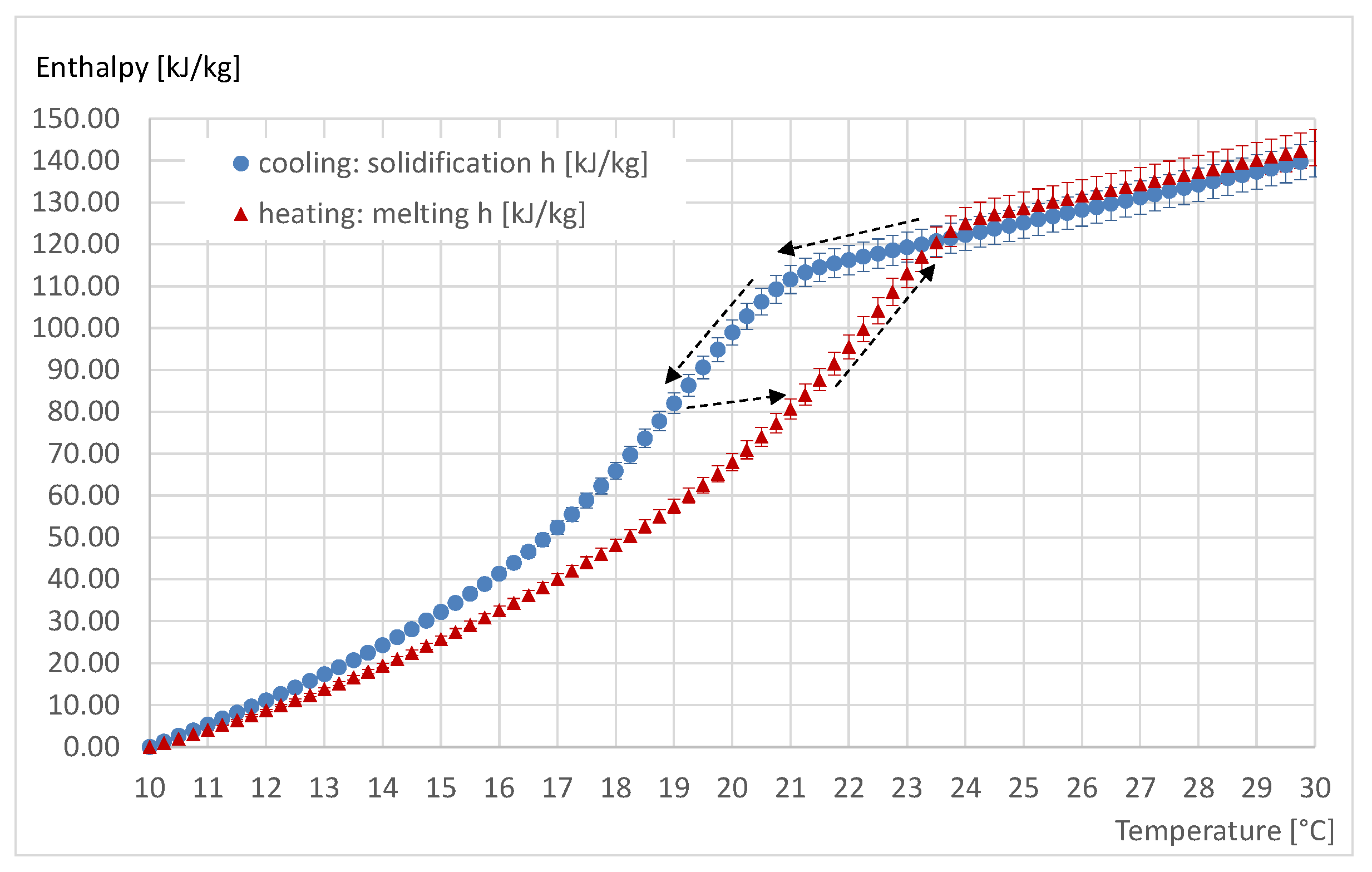

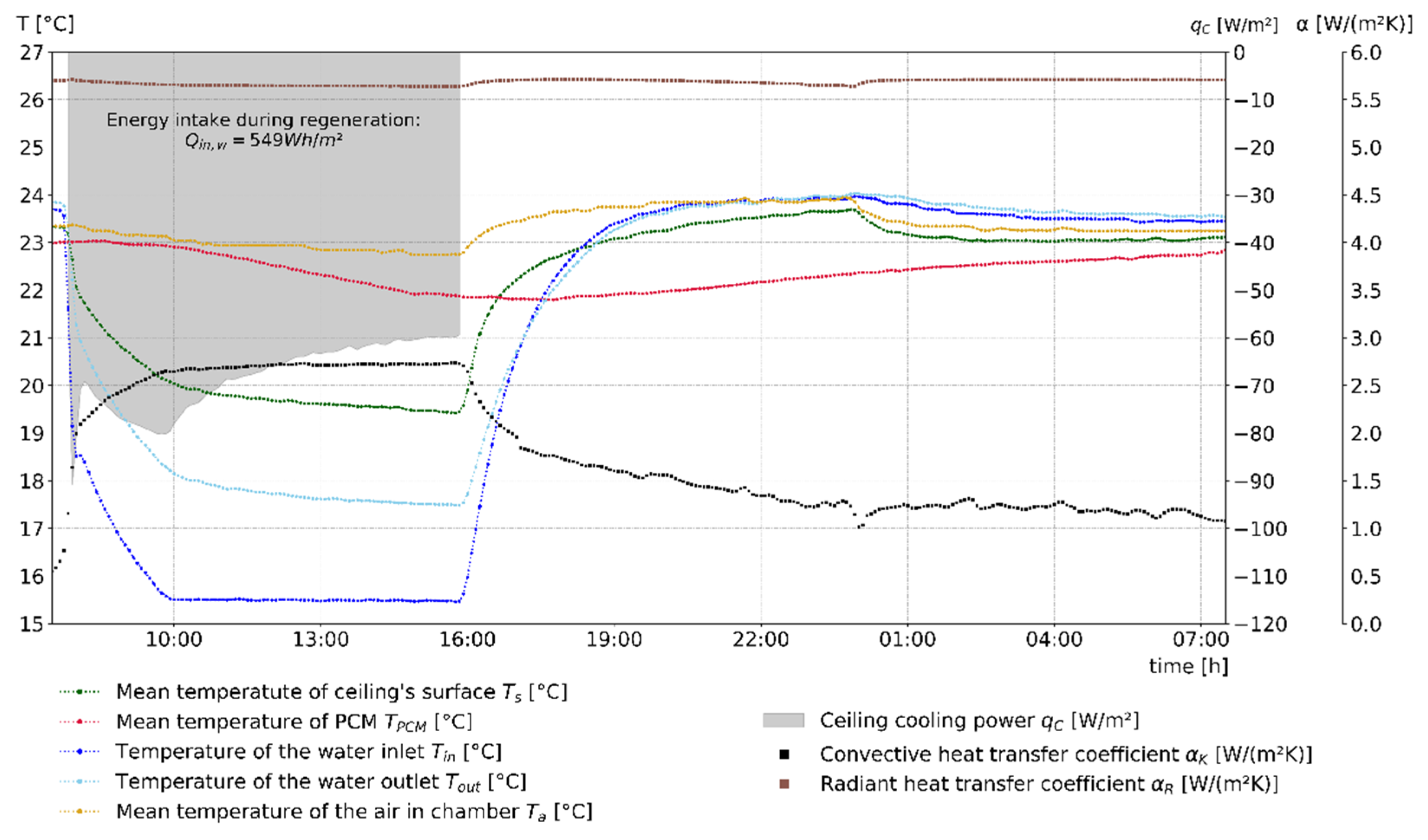
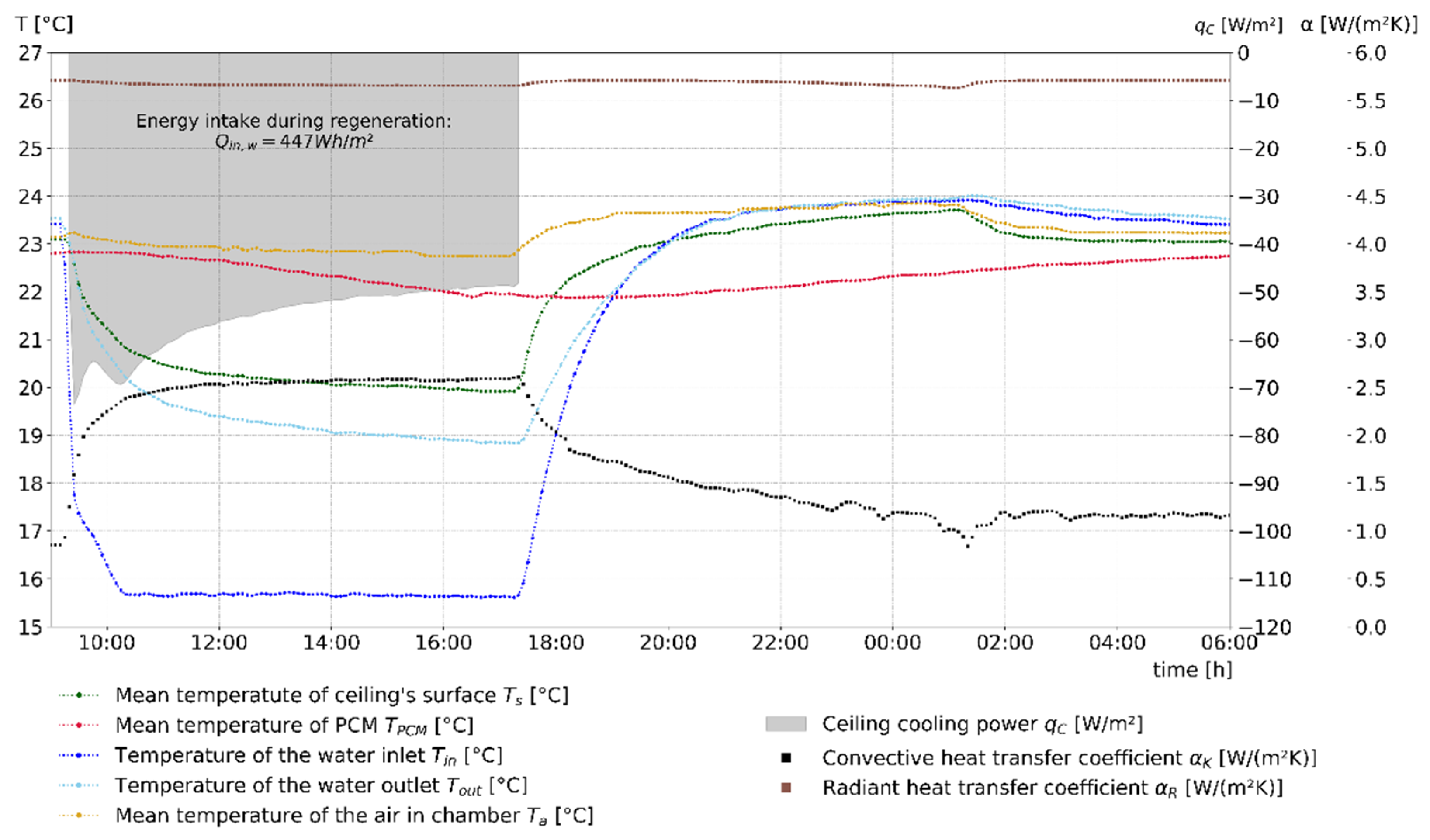
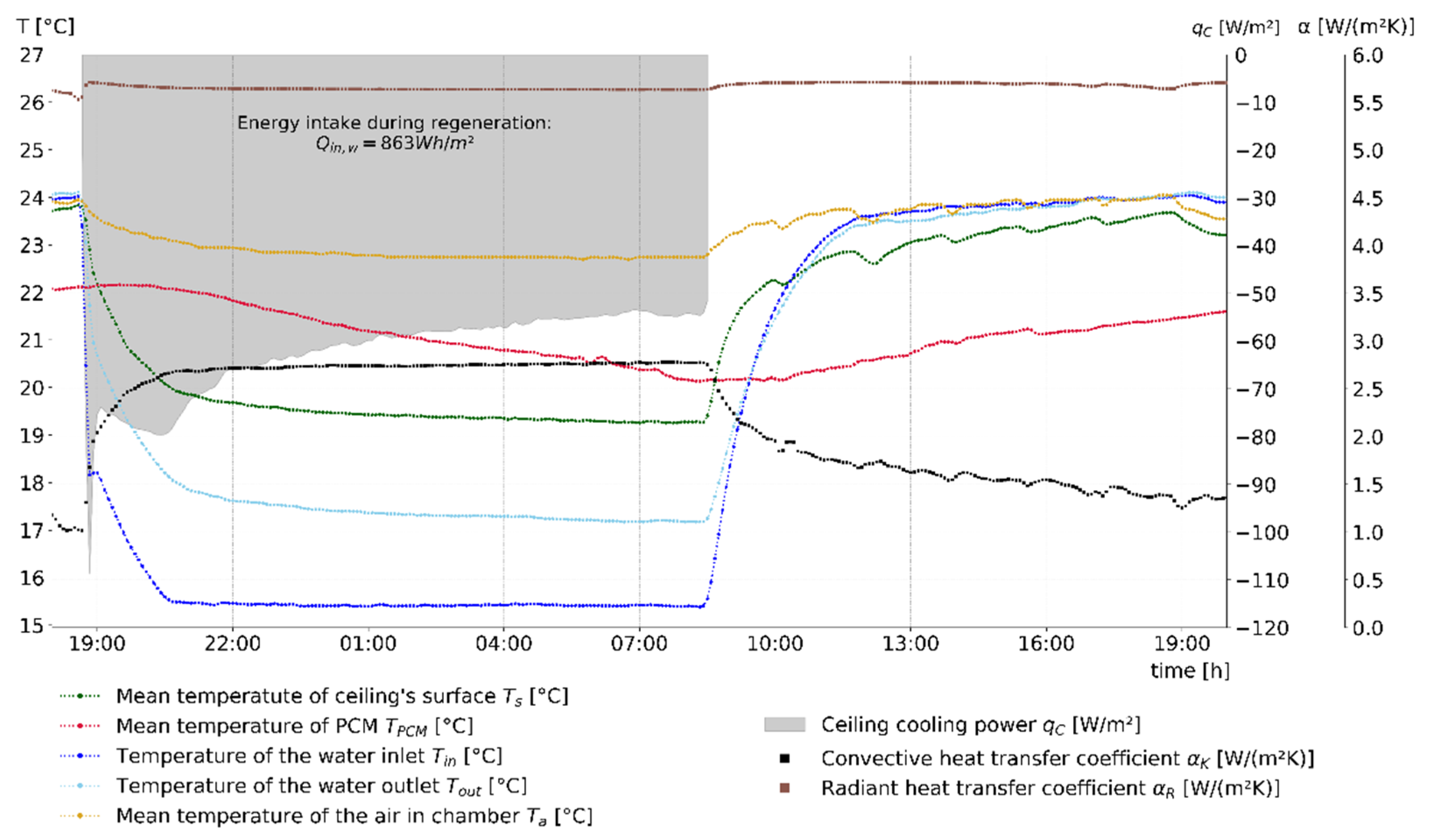
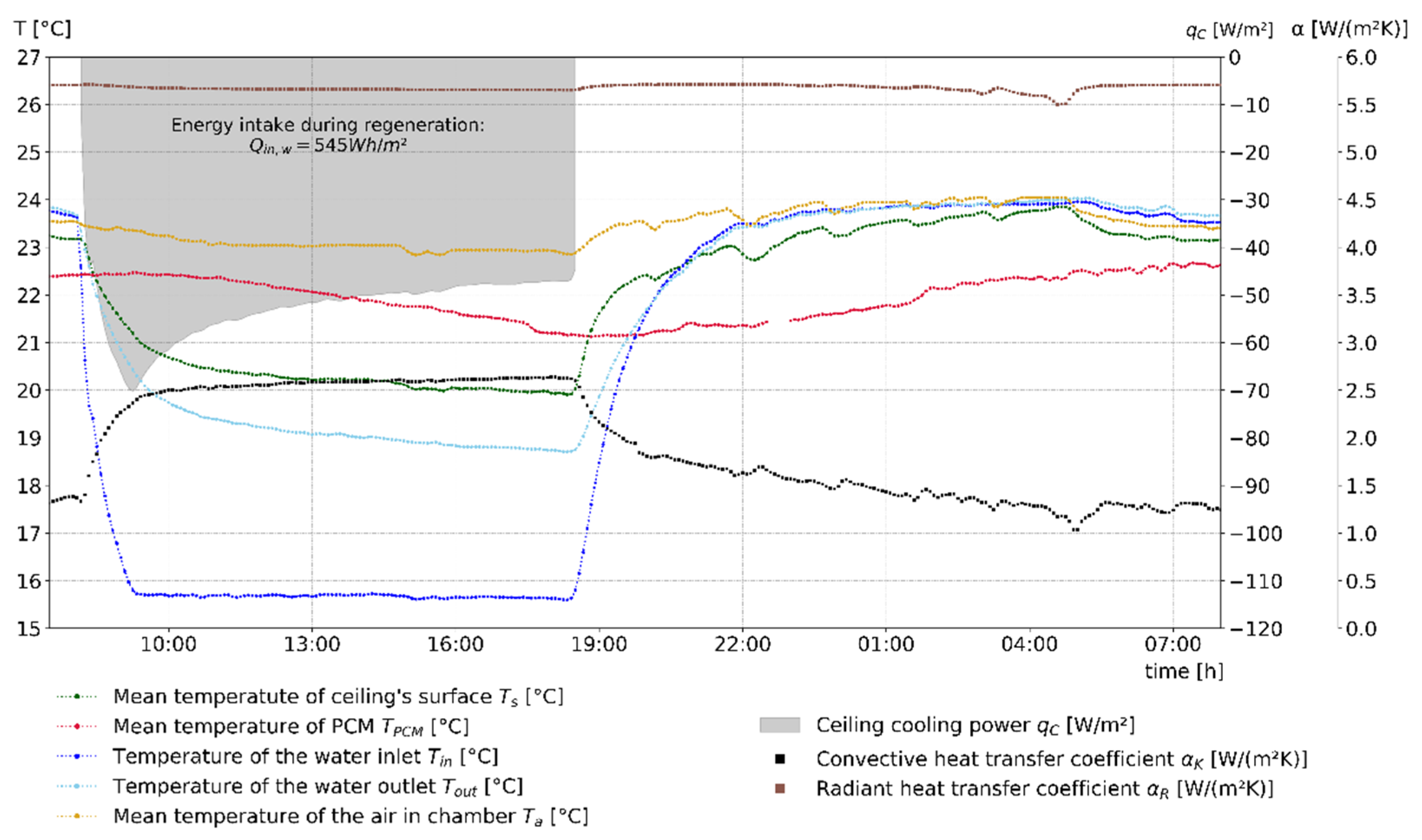

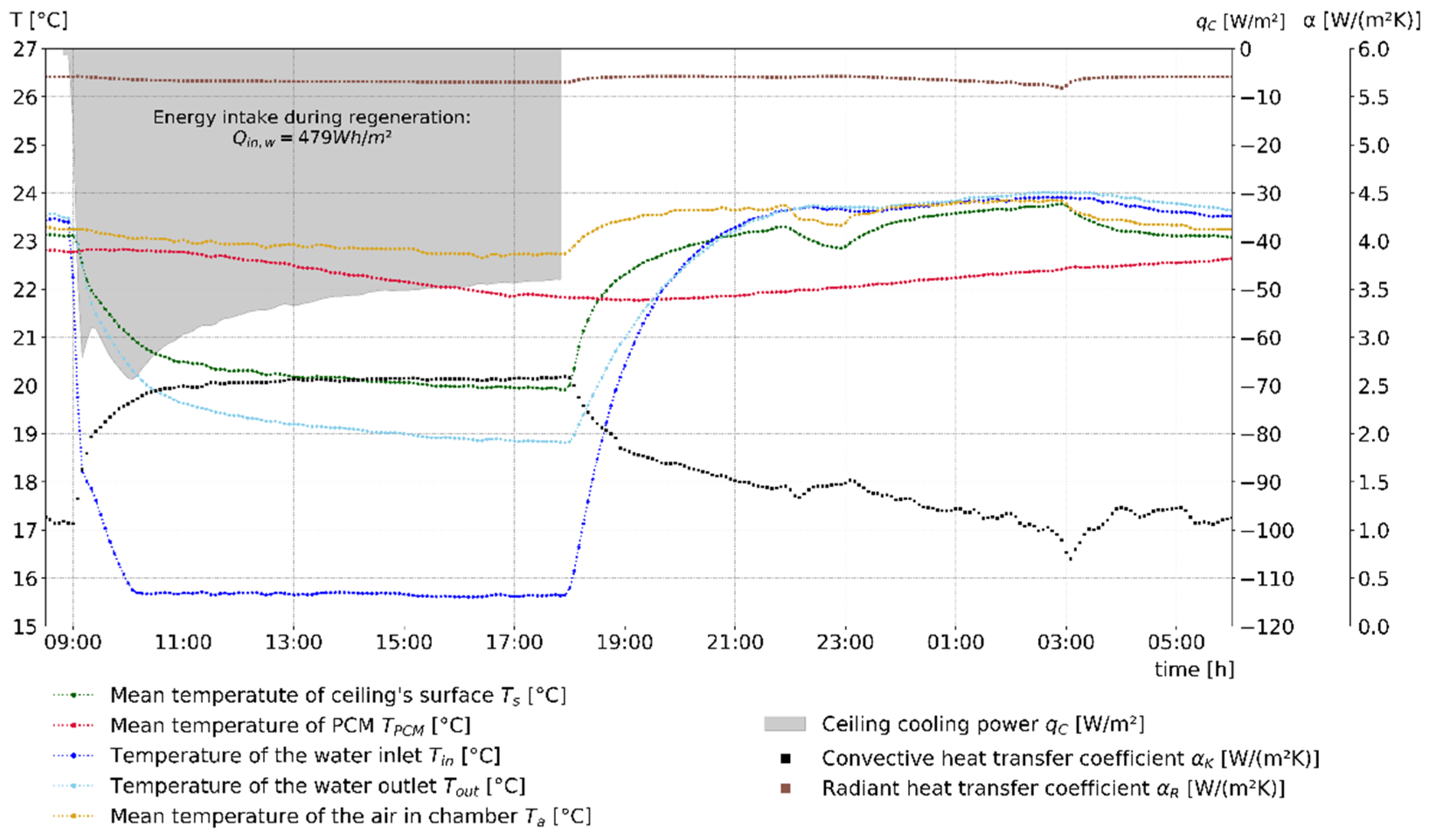
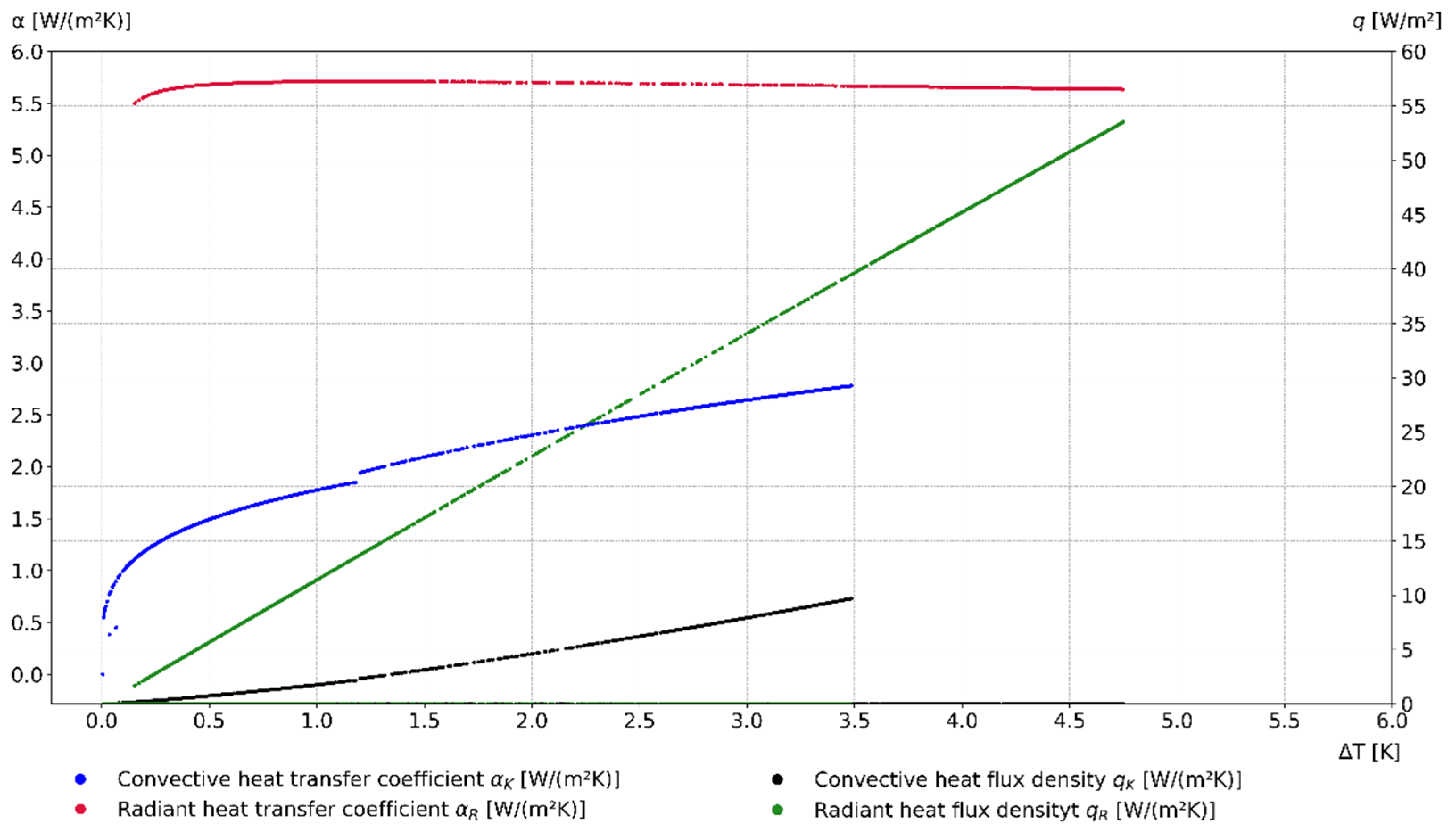

| Thermal Properties of Cooling Ceiling Modules | Activation Time |
|---|---|
| Cooling performance (according to the manufacturer) [W/m2] | (R2 = 0.9998) |
| Specific cooling capacity [W/m2] | (R2 = 0.9957) |
| Heat-flux density [W/m2] | (R2 = 1) |
| Convective heat transfer coefficient [W/(m2 K)] | (R2 = 1) |
| Radiant heat transfer coefficient [W/(m2 K)] | |
| Overall heat transfer coefficient [W/(m2 K)] | (R2 = 0.9165) |
| Variant | User Profile | Temperature of Water Inlet, Tin [°C] | |
|---|---|---|---|
| Ia | Office (8 h, 220 W) | 15.5 | 20.3 |
| Ib | Office (8 h, 220 W) | 15.5 | 10.0 |
| IIa | Educational (10:20 h = 6 × 1.5 h and breaks between, 220 W) | 15.5 | 21.0 |
| IIb | Educational (10:20 h = 6 × 1.5 h and breaks between, 220 W) | 15.7 | 10.4 |
| IIIa | Office (4 h + 4 h with 1 h break between work hours, 220 W) | 15.5 | 20.4 |
| IIIb | Office (4 h + 4 h with 1 h break between work hours, 220 W) | 15.5 | 10.4 |
| Activation Time | Work Hours | |
|---|---|---|
| Convective heat flux density [W/m2] | (R2 = 0.9978) | (R2 = 0.9995) |
| Radiant heat flux density [W/m2] | (R2 = 1) | (R2 = 1) |
| Convective heat transfer coefficient [W/(m2 K)] | (R2 = 0.9668) | (R2 = 0.9887) |
| Radiant heat transfer coefficient [W/(m2 K)] |
Publisher’s Note: MDPI stays neutral with regard to jurisdictional claims in published maps and institutional affiliations. |
© 2021 by the authors. Licensee MDPI, Basel, Switzerland. This article is an open access article distributed under the terms and conditions of the Creative Commons Attribution (CC BY) license (https://creativecommons.org/licenses/by/4.0/).
Share and Cite
Sinacka, J.; Szczechowiak, E. An Experimental Study of a Thermally Activated Ceiling Containing Phase Change Material for Different Cooling Load Profiles. Energies 2021, 14, 7363. https://doi.org/10.3390/en14217363
Sinacka J, Szczechowiak E. An Experimental Study of a Thermally Activated Ceiling Containing Phase Change Material for Different Cooling Load Profiles. Energies. 2021; 14(21):7363. https://doi.org/10.3390/en14217363
Chicago/Turabian StyleSinacka, Joanna, and Edward Szczechowiak. 2021. "An Experimental Study of a Thermally Activated Ceiling Containing Phase Change Material for Different Cooling Load Profiles" Energies 14, no. 21: 7363. https://doi.org/10.3390/en14217363






